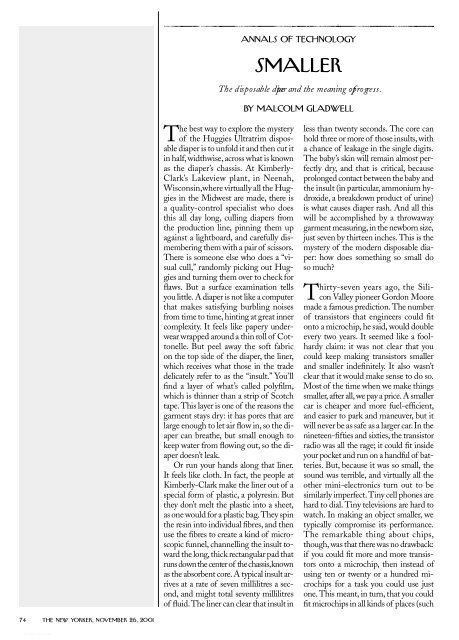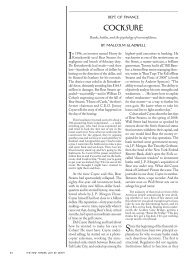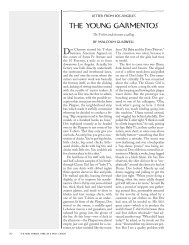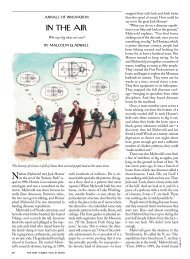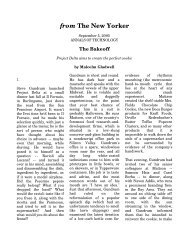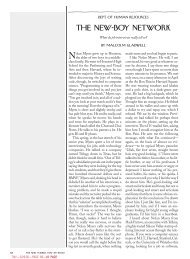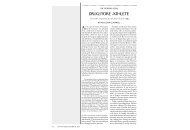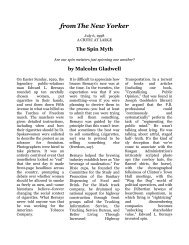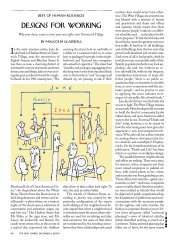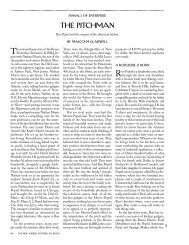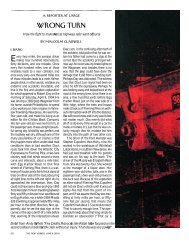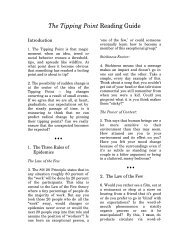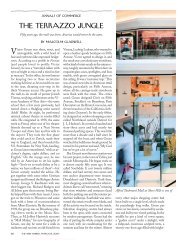SMALLER - Malcolm Gladwell
SMALLER - Malcolm Gladwell
SMALLER - Malcolm Gladwell
You also want an ePaper? Increase the reach of your titles
YUMPU automatically turns print PDFs into web optimized ePapers that Google loves.
7 4 THE NEW YO R K E R, NOVEMBER 26, 2001<br />
TNY—11/26/01—PAGE 7 4— 1 3 3 S C .<br />
ANNALS OF TECHNOLOGY<br />
<strong>SMALLER</strong><br />
The disposable diap er and the meaning ofp ro gre s s .<br />
BY MALCOLM GLADWELL<br />
The best way to explore the mys t e ry<br />
o f the Huggies Ul t ra t rim disposable<br />
diaper is to unfold it and then cut it<br />
in half,w i d t h w i s e,a c ross what is know n<br />
as the diaper’s ch a s s i s . At Kimberly -<br />
C l a rk ’s La k ev i ew plant, in Ne e n a h ,<br />
Wi s c on s i n ,w h e re virt u a lly all the Huggies<br />
in the Midwest are made, t h e re is<br />
a quality - c on t rol specialist who does<br />
this all day lon g, c u lling diapers from<br />
the pro d u c t i on line, pinning them up<br />
against a lightb o a rd ,and ca re f u lly dism<br />
e m b e ring them with a pair of s c i s s o r s .<br />
T h e re is som e one else who does a “v isual<br />
cull , ” ra n d om ly picking out Huggies<br />
and turning them over to ch e ck for<br />
fla w s . But a surface examination tell s<br />
you little. A diaper is not like a com p u t e r<br />
that makes satisfying burbling noises<br />
f rom time to time, hinting at great inner<br />
c om p l e x i ty. It feels like papery underwear<br />
wrapped around a thin ro ll of C o tt<br />
on e ll e . But peel away the soft fabric<br />
on the top side of the diaper, the liner,<br />
w h i ch re c e i ves what those in the tra d e<br />
d e l i ca t e ly re fer to as the “i n s u l t . ”Yo u’ll<br />
find a layer of w h a t’s ca lled polyfil m ,<br />
w h i ch is thinner than a strip of S c o t ch<br />
t a p e .This layer is one of the re a s on st h e<br />
g a rment stays dry: it has pores that are<br />
large enough to let air flow in, so the diaper<br />
can bre a t h e, but small enough t o<br />
keep water from flowing out, so the diaper<br />
doesn’t leak.<br />
Or run your hands along that liner.<br />
It feels like cl o t h .In fact, the people at<br />
K i m b e rly - C l a rk make the liner out of a<br />
special form of p l a s t i c ,a polyre s i n .B u t<br />
t h ey don’t melt the plastic into a sheet,<br />
as one would for a plastic bag.T h ey spin<br />
the resin into individual fib re s ,and then<br />
use the fib res to create a kind of m i c roscopic<br />
funnel, ch a n n e ling the insult tow<br />
a rd the l on g,t h i ck rectangular pad that<br />
runs down the center of the ch a s s i s ,k n ow n<br />
as the absorbent core .A typ i cal insult arri<br />
ves at a rate of s even mill i l i t res a secon<br />
d , and might total seve n ty mill i l i t re s<br />
o f flu i d .The liner can clear that insult in<br />
less than tw e n ty secon d s .The core ca n<br />
hold three or more of those insults, w i t h<br />
a chance of leakage in the single digits.<br />
The baby’s skin will remain almost perfe<br />
c t ly dry, and that is cri t i ca l , b e ca u s e<br />
p ro l onged contact between the baby and<br />
the insult (in part i c u l a r, a m m onium hyd<br />
rox i d e, a bre a k d own product of u ri n e )<br />
is what causes diaper ra s h .And all this<br />
w i ll be accomplished by a throw a w ay<br />
g a rment measuri n g,in the new b o rn size,<br />
just seven by thirteen inch e s .This is the<br />
m ys t e ry of the modern disposable diap<br />
e r : h ow does something so small do<br />
so mu ch ?<br />
Th i rty - s even years ago, the Si l i -<br />
c on Va ll ey pioneer Gord on Moore<br />
made a famous pre d i c t i on .The number<br />
o f t ransistors that engineers could fit<br />
onto a micro ch i p, he said, would double<br />
eve ry two ye a r s .It seemed like a foolh<br />
a rdy cl a i m : it was not clear that yo u<br />
could keep making transistors small e r<br />
and smaller indefin i t e ly. It also wasn’t<br />
clear that it would make sense to do so.<br />
Most of the time when we make things<br />
s m a ll e r, a fter all ,we pay a pri c e .A small e r<br />
car is cheaper and more fuel-effic i e n t ,<br />
and easier to park and maneuve r, but it<br />
w i ll never be as safe as a larger ca r.In the<br />
n i n e t e e n - fifties and sixties,the tra n s i s t o r<br />
radio was all the ra g e ;it could fit inside<br />
your pocket and run on a handful of b a tt<br />
e ri e s .B u t ,b e cause it was so small , t h e<br />
sound was terri b l e, and virt u a lly all the<br />
other mini-electronics turn out to be<br />
s i m i l a rly imperfe c t .Ti ny cell ph ones are<br />
h a rd to dial. Ti ny telev i s i ons are hard to<br />
w a t ch .In making an object small e r, w e<br />
typ i ca ly com p romise its perf o rm a n c e .<br />
The re m a rkable thing about ch i p s ,<br />
t h o u g h ,was that t h e re was no dra w b a ck :<br />
i f you could fit more and more tra n s i stors<br />
onto a micro ch i p, then instead of<br />
using ten or tw e n ty or a hundred mic<br />
ro chips for a task you could use just<br />
on e .This meant, in turn ,that you could<br />
fit micro chips in all kinds of places (such
D i ap ers are like micro ch i p s in , that they got better as they got smaller.<br />
as cellular ph ones and laptops) that yo u<br />
c o u l d n’t before, a n d , b e cause you were<br />
using one chip and not a hundre d ,c omputer<br />
power could be had at a fra c t i on of<br />
the pri c e, and because chips were now<br />
eve ry w h e re and in such demand they<br />
b e came even cheaper to make—and so<br />
on and so on .M o o re’s La w,as it came to<br />
be ca ll e d , d e s c ribes that ra re case in<br />
w h i ch there is no tra d e - o f fb e tween size<br />
and perf o rm a n c e .M i c ro chips are what<br />
might be termed a perfect innov a t i on .<br />
In the past tw e n ty ye a r s ,diapers have<br />
got smaller and small e r, t o o. In the early<br />
e i g h t i e s ,t h ey were three times bulkier<br />
than they are now, t h i cker and substant<br />
i a ly wider in the cro t ch .But in the mideighties<br />
Huggies and Procter & Gamb<br />
l e’s Pampers were reduced in bulk by<br />
TNY—11/26/01—PAGE 7 5—LIVE OPI ART—R 1 0 5 4 4 E P S — 1 3 3 S C GUIDANCE . — PROOF TO ARRIVE ON WEDS. A.M. POUCH<br />
fifty per cent; in the mid-nineties they<br />
s h rank by a third or so; and in the next<br />
few years they may shrink still more . I t<br />
seems re a s onable that there should have<br />
been a downside to this, just as there was<br />
to the shrinking of cars and ra d i o s :h ow<br />
could you reduce the amount of p a d d i n g<br />
in a diaper and not, in some way, c omp<br />
romise its ability to handle an insult?<br />
Ye t ,as diapers got small e r, t h ey got bett<br />
e r, and that fact elevates the diaper<br />
a b ove nearly all the thousands of o t h e r<br />
p roducts on the superm a rket shelf.<br />
K i m b e rly - C l a rk s ’ La k ev i ew plant is a<br />
huge facility,just down the fre ew ay from<br />
G reen Bay. I n s i d e, it is as immaculate as<br />
a hospital operating ro om .The walls and<br />
floors have been scrubbed white. T h e<br />
stainless-steel mach i n e ry gleams. T h e<br />
e m p l oyees are dressed in dark-blue pants,<br />
s t a rched light-blue button - d own shirt s ,<br />
and tissue-paper ca p s .T h e re are rows of<br />
m a chines in the plant,e a ch costing more<br />
than fifteen mill i on dollars—a dizzy -<br />
ing com b i n a t i on of c onveyor belts and<br />
w h i rling gears and chutes stre t ching as<br />
l ong as a city block and creating such a<br />
din that eve ryone on the factory flo o r<br />
wears headsets and com mu n i cates by<br />
ra d i o.C omputers monitor a mill i on data<br />
p o i n t sa l ong the way, i n s u ring that each<br />
o f those com p onents is pre c i s e ly cut and<br />
a t t a ched according to principles and<br />
p rocesses and materials pro t e c t e d ,on the<br />
Huggies Ul t ra t rim alon e, by hundreds<br />
o f p a t e n t s .At the end of the line, t h e<br />
Huggies come gliding out of the mach<br />
i n e,s t a cked upri g h t ,one after another<br />
in an endless row, l o oking like exq u i s -<br />
i t e ly formed slices of white bread in a<br />
toast ra ck .For ye a r s ,b e cause of M o o re’s<br />
La w, we have con s i d e red the micro ch i p<br />
the embodiment of the tech n o l o g i ca l<br />
a g e . But if the diaper is also a perfect<br />
i n n ov a t i on ,d o e s n’t it deserve a place beside<br />
the ch i p ?<br />
The modern disposable diaper was<br />
i nvented tw i c e,first by Victor Mill s<br />
and then by Carlyle Harm on and Billy<br />
Gene Harp e r. M i ls worked for Procter &<br />
G a m b l e, and he was a legend. I v o ry<br />
soap used to be made in an expensive<br />
and time-consuming batch - b y - b a t ch<br />
m e t h o d . M i lls fig u red out a simpler,<br />
c ontinuous pro c e s s .Du n can Hines ca k e<br />
m i xes used to have a problem blending<br />
flo u r,s u g a r,and shortening in a consistent<br />
mixture . M i lls introduced the<br />
m a chines used for milling soap, w h i ch<br />
g round the ingredients mu ch more<br />
fin e ly than before, and the result was<br />
New, I m p roved Du n can Hines ca k e<br />
m i x .E ver wonder why Pri n g l e s ,u n l i k e<br />
other potato ch i p s , a re all exactly the<br />
same shape? Because they are made like<br />
s o a p :the potato is ground into a slurry,<br />
then pre s s e d ,b a k e d ,and wra p p e d — a n d<br />
that was Victor Mill s ’s idea, t o o.<br />
In 1957, Procter & Gamble bought<br />
the Charmin Paper Com p a ny,o f G re e n<br />
B ay, Wi s c on s i n ,and Mills was told to<br />
think of n ew products for the paper<br />
b u s i n e s s .Since he was a gra n d f a t h e r —<br />
and had alw ays hated washing diapers—<br />
he thought of a disposable diaper.“ O n e<br />
o f the early re s e a rchers told me that<br />
a m ong the first things they did was go<br />
THE NEW YO R K E R, NOVEMBER 26, 2001 7 5
7 6 THE NEW YO R K E R, NOVEMBER 26, 2001<br />
TNY—11/26/01—PAGE 7 6—133SC.—LIVE OPI—A7068<br />
out to a toy store and buy one of t h o s e<br />
Betsy We t s y - type doll s , w h e re you put<br />
water in the mouth and it comes out the<br />
other end,” Ed Rider, the head of t h e<br />
a rch i ves department at Procter & Gamb<br />
l e, s ays . “T h ey brought it back to the<br />
l a b, h o oked up its legs on a tre a d m i l to<br />
make it walk, and tested diapers on it.”<br />
The end result was Pa m p e r s ,w h i ch were<br />
l a u n ched in Pe o ri a ,in 1961. The diaper<br />
had a simple rectangular shape.Its liner,<br />
w h i ch lay against the baby’s skin, w a s<br />
made of rayon .The outside material was<br />
p l a s t i c .In between were multiple laye r s<br />
o f crêped tissue.The diaper was attach e d<br />
with pins and fe a t u red what was know n<br />
as a Z fold, meaning that the edges of<br />
the inner side were pleated, to provide a<br />
better fit around the legs.<br />
In 1968, K i m b e rly - C l a rk bro u g h t<br />
out Kimbies,w h i ch took the re c t a n g u l a r<br />
diaper and shaped it to more cl o s e ly fit a<br />
b a b y’s body.In 1976,Procter & Gamble<br />
b rought out Lu vs ,w h i ch elasticized the<br />
leg openings to prevent leakage. But diapers<br />
still adhered to the basic Mill s i a n<br />
n o t i on of an absorbent core made out of<br />
paper—and that was a pro b l e m .Wh e n<br />
paper gets wet, the fluid soaks ri g h t<br />
th ro u g h ,w h i ch makes diaper rash worse.<br />
And if you put any kind of p re s s u re on<br />
p a p e r — i fyou squeeze it, or sit on it—it<br />
w i ll surrender some of the water it has<br />
a b s o rb e d ,w h i ch creates further diffic u lt<br />
i e s ,b e cause a baby,in the usual course of<br />
s q u i rming and crawling and walking,<br />
might place as mu ch as five kilopascals of<br />
p re s s u re on the absorbent core of a diap<br />
e r. Diaper-makers tried to address this<br />
s h o rt c oming by moving from crêped tissue<br />
to what they ca lled flu f f, w h i ch was<br />
b a s i ca ly fin e ly shredded cell u l o s e .T h e n<br />
t h ey began to compensate for paper’s<br />
failing by adding more and more of i t ,<br />
until diapers became huge.But they now<br />
had Moore’s Law in reve r s e :in order to<br />
get better, t h ey had to get bigger—and<br />
bigger still wasn’t ve ry go o d .<br />
C a rlyle Harm on worked for Joh ns<br />
on & J oh n s on and Billy Gene Harp e r<br />
w o rked for Dow Chemica l , and they<br />
had a solution .In 1966, e a ch filed separate<br />
but virt u a lly identical patent applica<br />
t i on s ,p roposing that the best way to<br />
s o lve the diaper puzzle was with a peculiar<br />
polymer that came in the form of l i ttle<br />
pepperlike flakes and had the rem<br />
a rkable ability to absorb up to thre e<br />
h u n d red times its weight in water.<br />
In the Dow patent, H a rper and his<br />
team described how they s p rinkled tw o<br />
g rams of the supera b s o rbent polym e r<br />
b e tween two tw e n ty - i n ch - s q u a re sheets<br />
o f nyl on bro a d cl o t h ,and then quilted<br />
the nyl on layers together. The makes<br />
h i ft diaper was “ t h e re a fter put into use<br />
in personal management of a baby of<br />
a p p rox i m a t e ly 6 months age.” A ft e r<br />
four hours, the diaper was re m ove d . I t<br />
n ow weighed a hundred and tw e n ty<br />
“ E xcuse me, but it’s important to get those drinks<br />
to those who need them the most.”
g ra m s , meaning the flakes had soaked<br />
up sixty times their weight in uri n e .<br />
H a rper and Harm on argued that<br />
it was quite unnecessary to solve the<br />
paper problem by stuffing the core of<br />
the diaper with thicker and thicker ro ll s<br />
o f s h redded pulp. Just a handful of s up<br />
e ra b s o rbent polymer would do the job.<br />
Thus was the modern diaper born .Si n c e<br />
the mid-eighties, K i m b e rly - C l a rk and<br />
Procter & Gamble have made diapers<br />
the Harper and Harm on way, p u ll i n g<br />
out paper and replacing it with supera<br />
b s o rbent polym e r.The old, p a p e r - fill e d<br />
diaper could hold,at most, two hundre d<br />
and seve n ty - five mill i l i t res of flu i d ,or a<br />
little more than a cup.To d ay,a diaper full<br />
o f s u p e ra b s o rbent polymer can handl e<br />
as mu ch as five hundred mill i l i t re s ,a lmost<br />
twice that.The ch i e f ch a ra c t e ri s t i c<br />
o f the Mills diaper was its simplicity:<br />
the insult fe ll dire c t ly into the core .B u t<br />
the presence of the polymer has made<br />
the diaper far more com p l e x . It takes<br />
l onger for the polymer than it does paper<br />
to fully absorb an insult, for instance. So<br />
another com p onent was added, the acq<br />
u i s i t i on laye r,b e tween the liner and the<br />
c o re .The acquisition layer acts like blotting<br />
paper, holding the insult while the<br />
c o re slow ly does its work ,and distri b u ting<br />
the fluid over its full length.<br />
Diaper re s e a rchers sometimes perf<br />
o rm what is ca lled a re-wet test, w h e re<br />
t h ey pour a hundred mill i l i t res of flu i d<br />
onto the surface of a diaper and then<br />
a p p ly a piece of filter paper to the diaper<br />
liner with five kilopascals of p re s s u re—<br />
the ave rage load a baby would apply to a<br />
diaper during ord i n a ry use. In a con t e mp<br />
o ra ry supera b s o rbent diaper, like a<br />
Huggies or a Pa m p e r s ,the filter paper<br />
w i ll come away untouched after one ins<br />
u l t .A fter two insults,t h e re might be 0.1<br />
m i ll i l i t res of fluid on the paper. A ft e r<br />
t h ree insults, the diaper will surre n d e r,<br />
at most, on ly two mill i l i t res of m o i st<br />
u re— w h i ch is to say that, with the aid<br />
o f s up e ra b s o rb e n t s ,a pair of Huggies or<br />
Pampers can effort l e s s ly hold,even under<br />
p re s s u re, a baby’s entire night’s w o rk .<br />
The heir to the legacy of B i lly Gene<br />
H a rper at Dow Chemical is Fre d ri c<br />
B u ch h o l z ,who works in Midl a n d ,M i chi<br />
g a n ,a small town two hours nort h w e s t<br />
o f D e t ro i t , w h e re Dow has its headq<br />
u a rt e r s .His labora t o ry is in the middl e<br />
o f the sprawling ch e m i cal work s ,a mile<br />
or two away from corp o rate headquar-<br />
TNY—11/26/01—PAGE 7 7— 1 3 3 S C .<br />
t e r s ,in a low,unassuming bri ck building.<br />
“We still don’t understand perfe c t ly how<br />
these polymers work , ”B u chholz said on<br />
a recent fall aft e rn o on. What we do<br />
k n ow, he said, is that supera b s o rb e n t<br />
p o lymers appear, on a microscopic leve l ,<br />
to be like a tightly bundled fis h e rm a n’s<br />
n e t . In the presence of w a t e r, that net<br />
d o e s n’t break apart into thousands of<br />
pieces and dissolve, like sugar. Ra t h e r, i t<br />
just unra ve l s ,the way a net would open<br />
up if you shook it out, and as it does the<br />
water gets stuck in the webbing. T h a t<br />
a b i l i ty to hold huge amounts of w a t e r,<br />
he said, could make supera b s o rb e n t<br />
p o lymers useful in fire fighting or irri -<br />
g a t i on ,b e cause slightly gelled water is<br />
m o re likely to stay where it’s needed.<br />
T h e re are supera b s o rbents mixed in with<br />
the sealant on the walls of the Chunnel<br />
b e tween England and Fra n c e, so if w a t e r<br />
leaks in the polymer will absorb the<br />
water and plug the hole.<br />
Right now, one of the major ch a llenges<br />
facing diaper tech n o l o gy, B u chholz<br />
said, is that urine is salty, and salt<br />
impairs the unra ve lling of the netting:<br />
s u p e ra b s o rbents can handle on ly a tenth<br />
as mu ch salt water as fresh water. “ O n e<br />
idea is to re m ove the salt from uri n e .<br />
M aybe you could have a puri f yi n g<br />
s c re e n , ”he said. I f the molecular stru ct<br />
u re of the supera b s o rbent were optim<br />
i ze d , he went on , its absorp t i ve cap<br />
a c i ty could increase by another five<br />
h u n d red per cent. “ Su p e ra b s o rb e n t s<br />
could go from absorbing three hundre d<br />
times their weight to absorbing fift e e n<br />
h u n d red times their weight. We could<br />
h a ve just one perfect part i cle of s u p e r -<br />
a b s o rbent in a diaper. I f you are going to<br />
d re a m ,w hy not make the diaper as thin<br />
as a pair of u n d e rw e a r ? ”<br />
B u chholz was in his labora t o ry, a n d<br />
he held up a small plastic cup filled with<br />
a few tablespoons of superabsorbent<br />
fla k e s ,e a ch not mu ch larger than a gra i n<br />
o f s a l t .“I t’s just a granular materi a l ,t ot<br />
a lly non t ox i c , ”he said. “This is about<br />
two gra m s . ”He walked over to the sink<br />
and filled a large beaker with tap water,<br />
and poured the contents of the beaker<br />
into the jar of s u p e ra b s o rb e n t .At fir s t ,<br />
nothing happened. The amounts were<br />
so dispro p o rt i onate that it looked as<br />
i f the water would simply engulf t h e<br />
fla k e s .B u t ,s l ow ly and steadily,the water<br />
began to thick e n . “Lo ok , ” B u ch h o l z<br />
s a i d .“I t’s becoming soupy. ”Su re enough,<br />
THE NEW YO R K E R, NOVEMBER 26, 2001 7 7
7 8 THE NEW YO R K E R, NOVEMBER 26, 2001<br />
TNY—11/26/01—PAGE 7 8—133SC.—LIVE SPOT—N44425A—PLEASE INSPECT AND REPORT ON QUALITY—#2 PAGE<br />
little beads of gel were form i n g.No t h i n g h e re, p e rh a p s ,is a partial explanation for<br />
else was happening: t h e re was no gas the great wave of c o rp o rate re s t ru c t u ri n g<br />
g i ven off, no burbling or sizzling as the that swept across Am e ri ca in the late<br />
ch e m i cal process took place.The super- eighties and early nineties: firms could<br />
a b s o rbent polymer was simply swall ow- d ow n s i ze their work f o rce because they<br />
ing up the water,and within minutes the had dow n s i zed their products.) An d ,b e-<br />
c ontents of the cup had thickened into cause using five plants to make diapers is<br />
what looked like slightly lumpy, s p on gy m o re efficient than using eight,it beca m e<br />
p u d d i n g.B u chholz picked up the jar and possible to improve diapers without ra i s-<br />
tilted it, to show that nothing at all was ing diaper pri c e s — w h i ch is import a n t ,<br />
c oming out. He pushed and prodded the b e cause the sheer number of diapers par-<br />
mass with his fin g e r.The water had disents have to buy makes it a pri c e - s e n s i t ei<br />
v<br />
a p p e a re d To . soak up that mu ch liquid,t h e p ro d u c t .Until re c e n t ly, diapers were fas-<br />
Victor Mills diaper would have needed a tened with little pieces of t a p e, and if t h e<br />
t h i ck bundle of paper tow e ll i n g. B u ch- p e r s on changing the diapers got lotion or<br />
holz had used a few tablespoons of s u- p owder on her fingers the tape wouldn’t<br />
p e ra b s o rbent fla k e s .Su p e ra b s o rbent was w o rk .A hook - a n d - l o o p, Ve l c ro-like fas-<br />
not mere ly better; it was s m a l l er. tener doesn’t have this pro b l e m .But it<br />
Why does it matter that the diaper<br />
got so small? It seems a tri v i a l<br />
was years before the hook-and-loop fastener<br />
was incorp o rated into the diaper<br />
ch a s s i s :until ove r - a l manufacturing costs<br />
t h i n g, ch i e fly a matter of c onvenience to w e re re d u c e d ,it was just too expensive .<br />
the parent taking a bag of diapers hom e Most import a n t ,t h o u g h ,is how size<br />
f rom the superm a rk e t .But it turns out a f fects the way diapers are sold. T h e<br />
that size matters a great deal. T h e re’s s h e lves along the aisles of a superm a rk e t<br />
a re a s on that there are now “n ew, i m- a re divided into increments of four fe e t ,<br />
p roved con c e n t ra t e d”ve r s i ons of l a u n d ry and the space devoted to a given pro d u c t<br />
d e t e r g e n t ,and that some cereals now ca t e go ry is almost alw ays a multiple of<br />
c ome in smaller boxe s .Sm a lness is one of t h a t .D i a p e r s ,for example, might be pre-<br />
those changes that send ripples thro u g h sented as a tw e n ty-foot set.But when di-<br />
the whole econ om y. The old disposable apers were at their bulkiest the space<br />
d i a p e r s for , example,c reated a tra n s p o rt a- re s e rved for them was never enough.“Yo u<br />
t i on pro b l e m .Tra c t o r -t railers are proh i b- could on ly get a limited number on the<br />
ited by law from weighing m o re than s h e l f, ”s ays Sue Kl u g, the president of<br />
e i g h ty thousand pounds when loaded. Catalina Marketing So l u t i ons and a for-<br />
T h a t’s why a tru ck ca r rying som e t h i n g mer exe c u t i ve for Albert s on’s and Sa fe-<br />
heavy and compact like bottled water or w ay.“ Say you on ly had six bags.Som e on e<br />
C a m p b e l’s l soup is “f u ll , ”when the tru ck c omes in and buys a few,and then som e-<br />
i t s e l fis still half e m p ty. But the diaper of one else comes in and buys a few more .<br />
the eighties was what is known as a “h i g h Now yo u’re out of s t o ck until som e on e<br />
c u b e” i t e m . It was bulky and not ve ry rew o rks the shelf, w h i ch in some super-<br />
h e a v y, meaning that a diaper tru ck was m a rkets might be a day or tw o. ”Ou t - o f -<br />
f u ll before it re a ched its weight limit. B y s t o ck rates are already a huge problem in<br />
cutting the size of a diaper in half, c om- the retail business.At any given time,on ly<br />
panies could fit twice as many diapers on about ninety - two per cent of the pro d u c t s<br />
a tru ck ,and cut tra n s p o rt a t i on expenses that a store is supposed to be ca r rying are<br />
in half.T h ey could also cut the amount of a c t u a ly on the shelf—which ,i f you con-<br />
w a rehouse space and labor they needed sider that the ave rage superm a rket has<br />
in half.And companies could begin to rethink<br />
their manufacturing opera t i on s .<br />
“D i s t ri b u t i on costs used to force you<br />
to have plants in lots of p l a c e s , ”Du dl ey<br />
Le h m a n ,who heads the Kimberly - C l a rk<br />
diaper business, s ays . “As that becom e s<br />
less and less of an issue, you say,‘Do I rea<br />
lly need all my plants?’ In the United<br />
St a t e s ,it used to take eight. Now it takes<br />
five . ” ( K i m b e rly -C l a rk didn’t close any<br />
p l a n t s .But other manufacturers did, a n d<br />
t h i rty - five thousand items, w o rks out to
“ R e m e m b r, es<br />
o n ,i t’s never too early to a strt<br />
saving for re t i re m e n t . ”<br />
tw e n ty-eight hundred products that are<br />
s i m p ly not there . ( For a highly effic i e n t<br />
retailer like Wa l - M a rt , i n - s t o ck ra t e s<br />
might be as high as ninety-nine per cent;<br />
for a struggling firm,t h ey might be in the<br />
l ow eighties.) But, for a fast-mov i n g,<br />
bulky item like diapers,the problem of res<br />
t o cking was mu ch worse. Su p e rm a rk e t s<br />
could have all o cated more shelf space to<br />
d i a p e r s ,o fc o u r s e,but diapers are n’t a part<br />
i c u l a rly pro fitable ca t e go ry for re t a i l e r s —<br />
p ro fit margins are about half what they<br />
a re for the gro c e ry depart m e n t .So re t a i lers<br />
would mu ch rather give more shelf<br />
space to a growing and lucra t i ve ca t e go ry<br />
like bottled water. “I t’s all a tra d e - o f f, ”<br />
Klug says . “I f you expand diapers four<br />
fe e t , yo u’ve got to give up four feet of<br />
s omething else.” The on ly way diapermakers<br />
could insure that their pro d u c t s<br />
would actually be on the shelves was to<br />
make the products small e r, so they could<br />
fit tw e lve bags into the space of s i x .An d<br />
i f you can fit tw e lve bags on a shelf, yo u<br />
can introduce diffe rent kinds of d i a p e r s .<br />
You can add pull-ups and pre m i u m<br />
diapers and low-cost private-label diapers,<br />
a ll of w h i ch give parents more option s .<br />
“We cut the cost of t ru cking in half, ”<br />
s ays Ra l ph Draye r, who was in charge of<br />
logistics for Procter & Gamble for many<br />
years and now runs his own supply - ch a i n<br />
c on s u l t a n cy in Cincinnati. “We cut the<br />
cost of s t o rage in half.We cut handling in<br />
h a l f,and we cut the cost of the store shelf<br />
in half, w h i ch is pro b a b ly the most ex-<br />
TNY—11/26/01—PAGE 7 9—LIVE OPI A6466—133SC.—#2 PAGE<br />
• •<br />
p e n s i ve space in the whole ch a i n . ”E ve rything<br />
in the diaper worl d ,f rom plant cl o sings<br />
and tru cking routes to product imp<br />
rovements and consumer choice and<br />
c onve n i e n c e,t u rn s ,in the end,on the fact<br />
that Harm on and Harp e r’s absorb e n t<br />
c o re was smaller than Victor Mill s ’s .<br />
The shame of i t ,t h o u g h ,is that Harm<br />
on and Harper have never been pro pe<br />
rly celebrated for their accom p l i s h m e n t .<br />
Victor Mills is the famous on e .When he<br />
d i e d ,he was given a Ti m e so b i t u a ry, i n<br />
w h i ch he was ca lled “the father of d i s p o sable<br />
diapers.”When Carlyle Harm on died,<br />
s even months earl i e r,he got four hundre d<br />
w o rds in Ut a h’s D e s eret New s, s t re s s i n g<br />
his con t ri b u t i ons to the Morm on Church .<br />
We tend to credit those who create an<br />
i d e a ,not those who perfect it, f o r g e t t i n g<br />
that it is often on ly in the perfe c t i on of a n<br />
idea that true pro g ress occurs. Pu t t i n g<br />
s i x ty-four transistors on a chip all ow e d<br />
people to dream of the future . Pu t t i n g<br />
four mill i on transistors on a chip actually<br />
g a ve them the future . The diaper is no<br />
d i f fe re n t .The paper diaper changed pare<br />
n t i n g. But a diaper that could hold four<br />
insults without leakage,keep a baby’s skin<br />
d ry, clear an insult in tw e n ty seconds fla t ,<br />
and would nearly alw ays be in stock ,eve n<br />
i f you arri ved at the superm a rket at eight<br />
o’ cl o ck in the evening—and that would<br />
keep getting better at all those things,ye a r<br />
in and year out—was another thing altog<br />
e t h e r. This was more than a good idea.<br />
This was something like perfe c t i on .♦<br />
THE NEW YO R K E R, NOVEMBER 26, 2001 7 9


